Contents
Description
Chompu is called Malabar plum or rose apple, mistaken for bell pepper or red pear. The fruit emits an exquisite rose scent and is an excellent thirst quencher. Its main advantages are low calorie content, pleasant sweet and sour taste and vitamin reserve, which will be appreciated by fans of a healthy lifestyle.
Chompu is comfortable in a humid tropical climate. The plant calmly tolerates cold snaps up to + 10 ° С and piercing storm winds, therefore it is often planted in coastal and mountainous regions.
The spread of the fruit around the world began in the middle of the 18th century, when sailors took it from Malaysia and Sri Lanka to the New World.
From Indochina and from the islands of the Pacific Ocean, the plant migrated to the Bermuda, Antilles, Caribbean archipelagos, to the countries of North and South America. In the nineteenth century, chompa began to be cultivated in the tropics of Africa, on the island of Zanzibar, Australia.
What does it look like
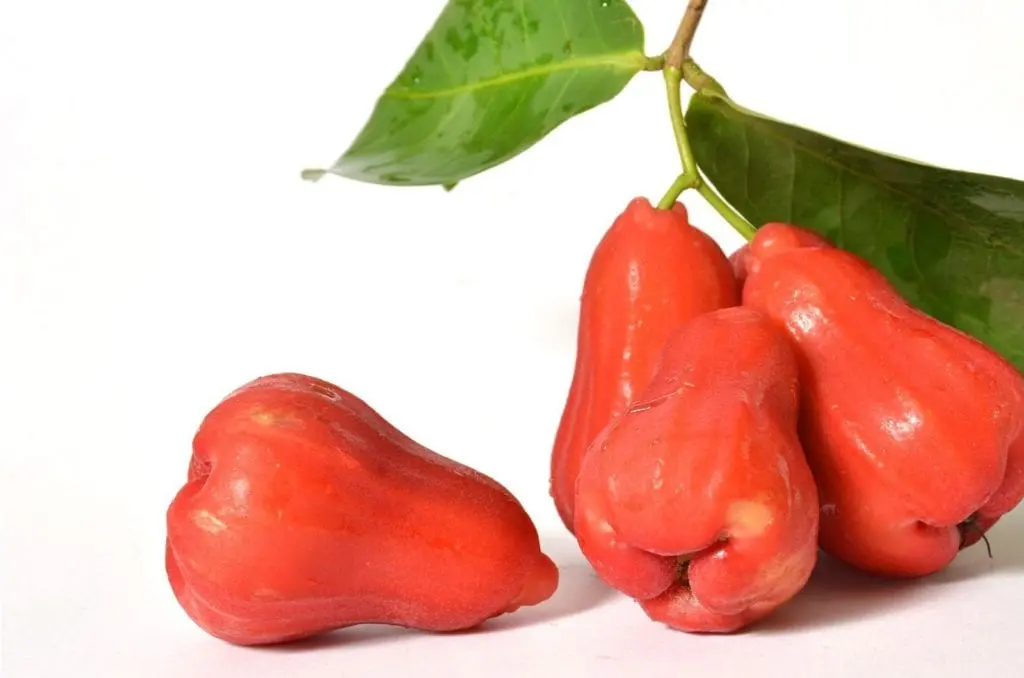
The chompu tree cannot boast of gigantic dimensions. Its average height is 12 m, and the diameter of the trunk is about 20 cm. The special pride of the plant is its dense bushy crown, which grows widely in width. Large elliptical leaves of juicy green color look fresh and aesthetically pleasing.
These features are also of practical benefit: they perfectly protect from the hot tropical sun, creating a wide shade. Worthy of attention are bright exotic flowers with green, pink, scarlet, snow-white or cream petals and three hundred thin golden stamens.
Despite being referred to as the Malabar plum and rose apple, the appearance of the fruit does not resemble either of these fruits. In shape, it looks like a pear or small bell pepper crumpled until facets appear. The length of the fruit is 5-8 cm, the diameter is no more than 5 cm. Traditional varieties are distinguished by their peel of pale pink or deep scarlet color. There are fruits with a light green skin.
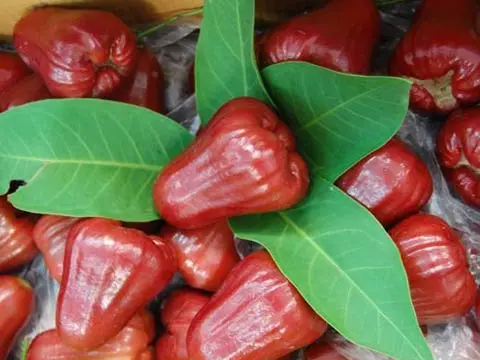
Due to the presence of ethylene in the composition, the fruits have a pleasant smell, reminiscent of the aroma of a garden rose. Local residents familiar with this feature of chompa make rose water from the fruit, which perfectly replenishes the lack of fluid in the body, smells good and has an exquisite taste.
There are practically no seeds in the fruits of reddish and pink shades. Sometimes soft translucent seeds come across that are easy to harvest. Green fruits are distinguished by the presence of rather large and dense seeds, however, there are not many of them, from 1 to 3 in each fruit. Their presence allows the plant to reproduce, however, they cannot be eaten due to the presence of bluish substances.
Chompu Taste
Chompu flesh is light yellow or white. The consistency can be airy and creamy, but more often it is more mealy and slightly crunchy, like an apple or pear. The fruit does not have a pronounced taste: it is rather neutral, slightly sweetish. The taste of an unripe fruit is interesting, reminiscent of a salad of bell pepper, green sour apple and fresh cucumber.
The lack of memorable exotic notes does not bring the fruit of popularity among travelers. However, the locals eat it regularly. So, in Thailand, it is one of the three most common and purchased. The reason for this is the high wateriness of the fruit, and this allows you to quench your thirst without water, which is especially important in hot Asian countries.
Composition and calorie content
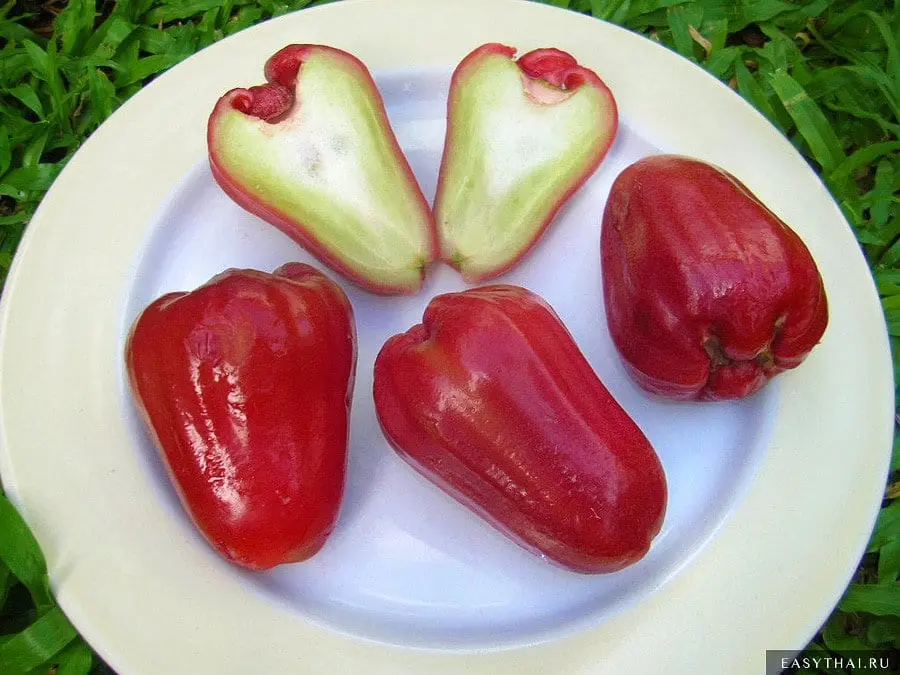
Malabar plum can be attributed to one of the most dietary foods on the planet: the energy value of the fruit is only 25 kcal, and there are 93 grams of water per 100 grams.
Even despite the presence of 5.7 grams of carbohydrates, eating chompu can harm the waist without fear, since the fruits are well absorbed. The fruit is high in vitamin C: 100 grams contains one fourth of the daily value.
100 g of chompu fruit contains only 25 kcal (104.6 kJ)
The benefits of chompu
Chompu is an irreplaceable helper for colds. It tones, lowers the temperature, thanks to the diuretic effect, it perfectly removes toxins from the body. The fruit has antibacterial properties, which helps in the fight against the causes of the disease. Fruit puree is recommended to be given to children while traveling to strengthen immunity and prevent ARVI.
Regular consumption of the rose apple normalizes the functioning of the gastrointestinal tract, helps digestion, and improves metabolism. Thanks to the complex of vitamins and minerals, the condition of the skin and hair improves, signs of hypertension disappear at an early stage, and puffiness disappears.
Contraindications
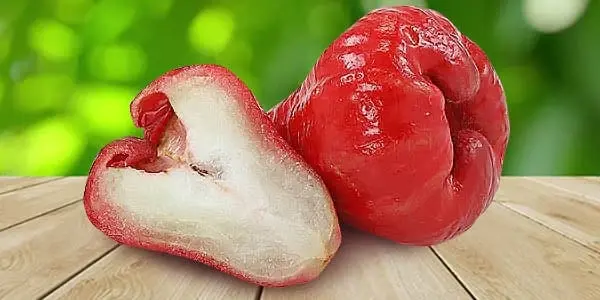
Chompu is one of the safest exotic fruits that has no contraindications other than individual intolerance. To exclude the possibility of allergies, the first intake of a rose apple should be limited to 1-2 fruits.
If during the next day there are no negative reactions from the body, you can safely include the product in the diet.
Children can be given fruit from a very early age, even introduced into the first complementary foods during breastfeeding. During pregnancy, you should give up any exotic products, but during lactation, mothers can try chompa, starting from the baby’s five months of age.
The main rule is not to eat seeds, as they can cause poisoning. Without indications, you should not use extracts, pomace and infusions from leaves – they contain hydrocyanic acid, and tree roots – they are saturated with poisonous alkaloids.
How to choose chompu
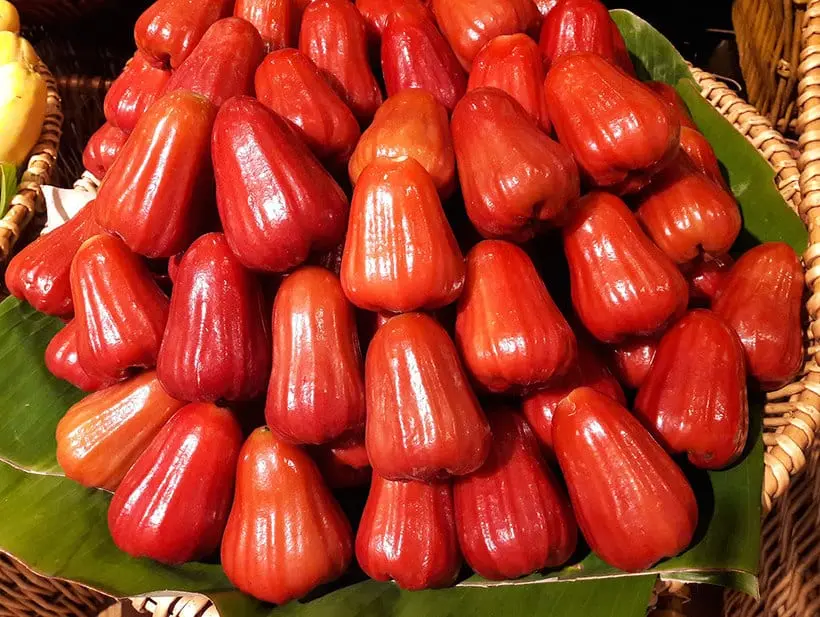
The main criterion for choosing a chompu is a smooth, shiny peel that tightly fits the fruit. It should be free of rot, cuts and other damage, dents and cracks. But you shouldn’t be guided by color: fruits of scarlet and greenish shades are equally tasty.
Since the fruit is prized for its juiciness and thirst quenching ability, you can ask the seller to cut one of the fruit. If it is ripe, if damaged, clear juice will sprinkle from the rind, which will continue to flow out after squeezing the chompu between the fingers.
Human use of chompu
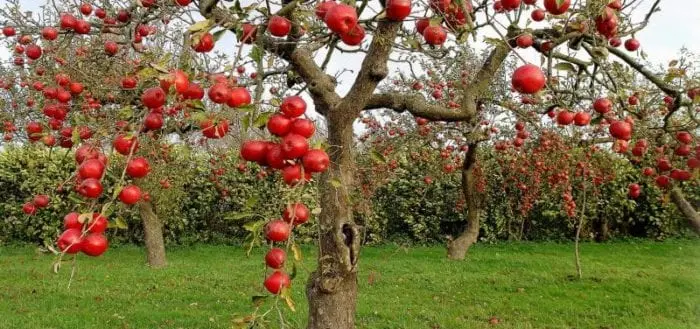
Chompa leaves should not be eaten, but a valuable extract is extracted from them, which is widely used in cosmetology and perfumery. Like the taste of a fruit, its aroma cannot be called bright, but it perfectly complements complex perfume compositions, emphasizing more intense notes.
The leaves of the plant are used to create cleansing and pore-tightening lotions, added to whitening and toning masks and creams. Thanks to the antibacterial effect, cosmetics help to fight irritations, acne and eliminate skin imperfections.
Chompu wood is characterized by strength, beauty, environmental friendliness and durability. It is used for the production of home furniture and musical instruments, decoration materials. They also found application for tree bark: it serves as a source of coloring pigment.









